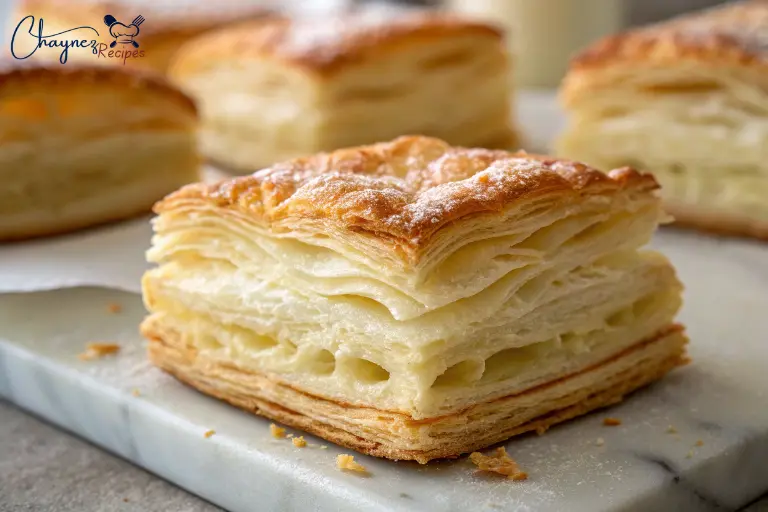Puff pastry is a culinary favorite for both professional chefs and home bakers alike. Its flaky, buttery layers make it the perfect base for a wide variety of dishes, from savory appetizers to sweet desserts. However, when it comes to working with puff pastry, a common question arises: Should I bake puff pastry before filling it? This seemingly simple query can make a significant difference in the texture and overall success of your recipe.
Whether you’re preparing a rich, creamy filling or a simple, dry filling, knowing when to bake puff pastry before filling it is key to achieving the best results. While puff pastry is designed to puff up in the oven, adding a filling at the right time can either enhance its crispness or lead to sogginess. Throughout this guide, we’ll discover the best practices for baking puff pastry, helping you understand exactly when and why you should pre-bake it or skip that step entirely.
So, should you bake puff pastry before filling it? The answer is nuanced, and it depends on the type of filling and the dish you’re making. By the end of this article, you’ll have a clearer understanding of how to handle puff pastry in different recipes and when to take the extra step of prebaking it for a perfectly crisp and golden result.
What is Puff Pastry?
Puff pastry is a flaky, buttery dough made by layering dough and butter, then rolling and folding it multiple times. The result is a dough that puffs up when baked due to the steam created by the layers of butter and dough. This unique structure makes puff pastry ideal for both savory and sweet dishes, ranging from appetizers to desserts.
Should I Bake Puff Pastry Before Filling It?
One of the most common questions when preparing puff pastry is whether to bake it before filling it or not. The answer depends on the recipe and the type of filling you’re using.
When to Bake Puff Pastry Before Filling
In many cases, you should bake puff pastry before adding the filling, especially for the following reasons:
- Prevent sogginess: Some fillings, especially wet ones like creamy sauces, vegetables, or fruits, can cause the pastry to become soggy if placed in raw dough.
- Achieve a crispy texture: Baking the pastry before adding the filling ensures that the layers puff up and turn golden and crisp, which is often desirable in savory tarts, turnovers, or pastries.
- Time management: If your filling requires less baking time, prebaking the pastry gives you more control over the final texture.
When You Can Skip Pre-baking the Puff Pastry
However, there are certain instances when it’s perfectly fine to skip prebaking:
- For dry fillings: If your filling is relatively dry, such as cooked meats or cheeses, you can often skip the prebaking step.
- For dishes that will bake for a long time: If the filling and the puff pastry will bake for an extended period (such as a pot pie or a filled pastry that will cook at 375°F for 40 minutes), the pastry will puff up and cook fully in the oven.
How to Pre-bake Puff Pastry
If you decide to pre-bake your puff pastry, here’s how to do it effectively:
- Chill the pastry: After rolling out your dough, chill it for about 15 minutes to firm it up. This helps maintain its structure during baking.
- Dock the pastry: Use a fork to gently prick the dough all over. This helps prevent large air bubbles from forming and allows the pastry to bake more evenly.
- Bake on parchment paper: Place your pastry on a baking sheet lined with parchment paper to avoid sticking.
- Use baking weights: If you are baking a larger piece of pastry, consider using pie weights or dry beans to weigh it down so the dough doesn’t puff up too much.
- Bake until golden: Bake at 400°F for 15–20 minutes, or until the pastry is golden and fully puffed.
The Importance of Using the Right Filling
When you bake puff pastry before adding the filling, the type of filling you use plays a crucial role in the outcome. Wet fillings require more attention to prevent sogginess, while drier fillings are less of a concern.
Wet vs. Dry Fillings: What to Know
- Wet fillings: Cream-based sauces, custards, or juicy fruits can cause the pastry to become soggy. Prebaking the pastry helps to create a barrier between the filling and the dough.
- Dry fillings: Meats, cheese, and cooked vegetables are less likely to release moisture, making them ideal for using in puff pastry without prebaking.

Tips for Working with Puff Pastry
Whether you decide to bake puff pastry before filling it or not, there are several tips you should keep in mind for the best results.
Handle Puff Pastry with Care
Puff pastry is delicate and can easily lose its flaky texture if handled too roughly. Keep the following points in mind:
- Keep it cold: Puff pastry should always be kept cold until ready to bake. If the butter begins to melt, the pastry will lose its ability to puff properly.
- Don’t overwork the dough: When rolling the dough, do it gently to preserve the layers. Overworking the dough can lead to less puffiness.
- Use sharp tools: When cutting puff pastry, use a sharp knife or pastry cutter to avoid flattening the layers.
Use a Clean Surface for Rolling
When rolling out puff pastry, ensure you’re using a clean, lightly floured surface. Excess flour can prevent the dough from rising properly, so use sparingly.
Precook Fillings When Necessary
Some fillings may benefit from precooking, particularly if they release a lot of moisture. This is especially true for vegetables or meats. Make sure your filling is cooked thoroughly and any excess liquid is removed before adding it to the pastry.
Add Egg Wash for a Golden Finish
To get that perfect golden-brown color on your baked puff pastry, brush it with an egg wash (a mixture of egg yolk and water). This will help the pastry achieve an attractive, shiny finish when it’s baked.
Common Puff Pastry Recipes and Whether to Pre-bake
Let’s take a look at some common recipes using puff pastry and discuss whether prebaking is necessary.
Puff Pastry Tarts
Puff pastry tarts, whether savory or sweet, are one of the most popular ways to use puff pastry. When making a tart, it’s generally recommended to prebake the pastry, especially if you’re using wet fillings like cream cheese, custard, or fruit. This ensures that the bottom crust stays crispy and doesn’t become soggy.
Puff Pastry Turnovers
Turnovers are typically filled with a variety of fillings, from fruit to cheese or meats. For fruit-based turnovers, prebaking is often a good idea to prevent moisture from making the pastry soggy. However, if you’re using drier fillings like cheese or cooked meats, you can skip this step.
Pot Pies
When making pot pies, you don’t need to prebake the puff pastry. The filling is often thick and will bake for an extended period, so the pastry will puff up perfectly as it cooks.
How to Store Puff Pastry
Puff pastry is best used fresh, but if you have leftovers or want to prepare it ahead of time, here’s how to store it:
- Refrigerator: Keep the dough in the refrigerator for up to 2–3 days if you plan to use it soon.
- Freezer: You can freeze puff pastry for up to a month. Be sure to wrap it tightly in plastic wrap and aluminum foil to prevent freezer burn.
FAQs: Should I Bake Puff Pastry Before Filling It?
1. Should I bake puff pastry before filling it?
Yes, in many cases, you should prebake puff pastry, especially if you’re using wet fillings. Prebaking helps prevent sogginess and ensures a crispy texture.
2. When is it not necessary to bake puff pastry before filling it?
If your filling is dry, such as cooked meats, cheese, or vegetables, you can skip prebaking. The pastry will cook and puff up nicely when baked with the filling inside.
3. What happens if I don’t bake puff pastry before filling it?
If you don’t prebake puff pastry, fillings that release moisture could cause the dough to become soggy. This is more common with creamy or fruit-based fillings.
4. How do I prevent puff pastry from becoming soggy?
To avoid sogginess, prebake puff pastry when using wet fillings. Additionally, make sure your filling is not too wet, and use an egg wash to seal the edges of the pastry.
5. Can I bake puff pastry with the filling from the start?
Yes, you can. For fillings that are not too moist, you can bake the pastry and filling together, especially if the dish will cook for a longer time and allow the pastry to puff and crisp properly.
Conclusion: Should I Bake Puff Pastry Before Filling It?
In summary, should I bake puff pastry before filling it? The answer depends on the type of filling you’re using and the desired outcome. For wet fillings like creamy sauces or juicy fruits, prebaking puff pastry is essential to prevent sogginess and ensure a golden, crispy texture. However, if you’re using drier fillings like meats or cheeses, you can often skip the prebaking step and let the filling bake along with the pastry.
Knowing when to prebake your puff pastry is key to achieving that perfect balance between crispy and flaky. Whether you’re crafting a savory tart, a sweet turnover, or a hearty pot pie, following the right techniques will help you create mouthwatering dishes every time. Don’t forget to handle the pastry gently, keep it cold, and use a sharp tool for cutting to maintain those delicate layers.
For more culinary inspiration, check out some of our delicious recipes like Alfredo Chicken Noodle Soup, a creamy, comforting dish perfect for cozy nights, or Steak Alfredo Recipe for a rich, savory dinner. If you’re in the mood for something hearty, don’t miss out on our Chicken Alfredo Soup with Beef and Parmesan Cheese, which combines tender chicken, flavorful beef, and creamy cheese for an unforgettable meal.
By understanding how and when to bake puff pastry before filling it, you’ll be able to create a variety of delicious and perfectly baked treats that will impress your family and guests alike.
And don’t miss out on more great ideas for healthier baking and cooking. For additional tips, recipes, and updates, follow us on Chaynez Recipes to access our latest posts and social media links.






